ANNUAL REVIEW for SAICE NPO and its subsidiary SAICE Pty Ltd





FROM THE PRESIDENT’S PERSPECTIVE
02 The year in review
04 President’s Award
05 Honorary Fellows
EDUCATION & TRAINING
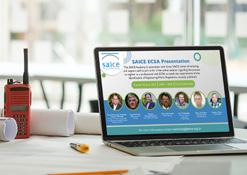
06 SAICE Academy: Building the puzzle
MEMBERSHIP
10 Representing the civil engineering profession
SAICE FUTURE LEADERS
14 Future Leaders Panel: 2022 highlights and achievements
20 16 10
SAICE AWARDS
16 SANRAL SAICE 2022 National Awards: Sustaining the future of the civil engineering industry

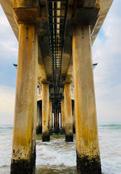
CAREER DEVELOPMENT
20 International Bridge Building Competition: Showcasing bright young minds
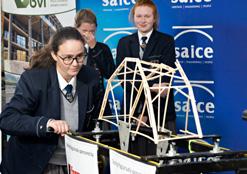
22 AQUALIBRIUM: Changing learners’ lives one water competition at a time
EDITORIAL
24 Civil Engineering Magazine
25 SAICE Journal
FINANCE AND ADMINISTRATION
28 2022 Financial Results
The year 2022 was an interesting one. Emerging from the Covid-19 pandemic, we were all a little nervous to meet face to face, navigating the awkwardness of having to shake hands, nevermind giving each other a hug. As we slowly got used to our old ways of interacting, we were shocked by the war in Ukraine, which marked the first fighting on European soil since World War II. Besides the human suffering, I watched in horror as infrastructure was slowly but surely destroyed. If that was not enough to wake us up after our Covid-19 hibernation, the floods in KwaZulu-Natal and the Eastern Cape did. Over 250 lives were lost, and the area is still suffering as a result of the damage to infrastructure and businesses.
The effect of the pre-2022 hibernation was felt most in the various institutions of higher learning that I visited during my tenure as President of SAICE. Students suffered because of the lack of interaction and were eager to hear what
SAICE is doing, and how they could better connect with the Institution.

SAICE Connect was welcomed by the students and industry partners we visited. Although frightening, the students also enjoyed the fact that I alerted them to the need for engineering professionals in South Africa, as infrastructure is aging while the population is growing. Personally, I was humbled by the warm welcome I received from staff and students at the institutions of higher learning. Thank you all for the care you took in planning the many events I attended, especially the SAICE student chapters involved. To the students, thank you for choosing this honourable profession and I cannot wait to see you in the industry making your mark.
Every stop I made during the year – and there were many – I interacted with various industry partners. I have heard your challenges about the lack of investment in civil infrastructure, the slow pace of tender awarding, and professional registration issues, among others. SAICE National Office is interacting with various stakeholders and we will continue to support you. From my side, thank you all for the warm welcome and hospitality.
Although it comes as a result of the horrifying floods, one of my highlights was visiting the site in Durban where a large part of a slope had washed away. The way the engineering team was rebuilding and reinforcing the slope, stabilising structures, and planning the reclamation of a block of residential apartments was fascinating. It was a prime example of excellence in engineering – these are the unsung heroes of our country. To the team that
is making this happen, thank you for sharing the marvellous work you are doing.
Of course, I cannot write a reflection on my year, without mentioning the SAICE branches and divisions. Thank you all for the work you do during the year, in the various corners of the country. It has been fascinating spending time with members, unpacking challenges and discussing solutions. What we need now is for government and private funders to make budget available to implement pipeline projects and initiatives. To all the SAICE volunteers out there, thank you for the never-ending contributions you make to South Africa and the Institution.
Over the past year SAICE was in the media several times, commenting on the State of the Nation Address, the National Budget and various other topics, such as tender issues and crime in the construction industry. We have realised that we need to find ways to share this with members too. In this regard, we ask you, our members, to ensure that you follow us on all social media platforms in order to stay engaged with developments in the industry.
Reflection




highlights and lowlights is captured best in SAICE’s latest Infrastructure Report Card. It makes me very proud that in 2022 SAICE collectively produced the fourth edition of this document. Thank you to all volunteers involved, especially Sam Amod and Prof. Kevin Wall.
Finally, I want to mention the incredible calculator drive that was organised in 2022. Funding was raised to purchase and distribute close to 350 scientific calculators to learners in KwaZuluNatal, Free State, Gauteng and Western Cape. Thank you to all the funders and volunteers who assisted in this initiative. May the legacy last long.

As I look back on my tenure, I have realised the need to start interacting with scholars at an early stage. Various ideas to reach primary school learners are circling in my mind and these will hopefully be developed soon. Thank you to the various people who have already offered to assist. To the rest of the membership, watch this space.
Yours,
Prof. Marianne Vanderschuren 2022 SAICE PresidentThe President’s Award honours an individual who has rendered excellent service to the Institution and the profession. After much deliberation an exception was made, allowing 2022 SAICE President Prof. Marianne Vanderschuren to present the 2022 award to two deserving candidates: Tauqeer Ahmed and Sharon Shunmugam.
Tauqeer Ahmed (PR Tech Eng) holds a Master’s in Technology in Civil Engineering and is currently the Head of the Engineering Centre of Excellence at the Transnet National Ports Authority (TNPA) Headquarters.
Tauqeer has a long history with SAICE. He served as a Council member from 2019 to 2021 and is a member of the Membership Committee and Marine Division Committee. In 2019 Tauqeer volunteered to champion the SAICE Knowledge Trailblazer, which formed part of the new SAICE Growing Forward campaign.
He has authored numerous articles focusing mainly on maintenance issues and has interviewed various professionals to share their knowledge with the greater SAICE community, and in particular to ensure that new knowledge is constantly made available to members. Moreover, he has made significant efforts to collaborate with sister institutions to bring their knowledge and technological developments into the Knowledge Trailblazer fold.
In 2017 Tauqeer was awarded SAICE’s Technologist of the Year award in recognition of his work done at TNPA’s Port of Ngqura.
Sharon Shunmugam (PR Tech Eng, FSAICE, PMP) is an adept and respected professional in the project management and construction management disciplines, having lead projects for well-known clients in both the public and private sectors.
She has been active on a branch level for years, leading the SAICE Durban branch in 2021 and 2022, during which time it was awarded Branch of the Year twice. Under her leadership the Durban branch grew considerably and is now almost 1 700 members strong.

As the Chairperson for SAICE Durban, Sharon led the branch to new heights. When KwaZulu-Natal faced terrible floods in 2022, she coordinated SAICE volunteer efforts in the area, in addition to organising the branch’s community upliftment projects, including two highly successful Winter Warmth drives and two Christmas outreach initiatives. The most recent initiative was a calculator drive which saw 350 scientific calculators distributed throughout South Africa.
Sharon is a Fellow of SAICE and a member of the SAICE Executive Board. She was also recently appointed to serve as the Vice President of the SACPCMP.

An Honorary Fellow is a person of distinction whom SAICE wishes to honour because of their services to the Institution and the profession. Four members were honoured with this distinction in 2022: Andrew Baird, Francis Gibbons, Dr Malcolm Mitchell, and Arthur Taute.
A member of SAICE for over 40 years, Andrew Baird is an exemplary leader with a background in the design office of a variety of hydro-electric and tunnelling projects in the UK, USA and South Africa, and several years’ experience on construction sites with major contractors. With experience in NEC project management, this gentleman is a recognised leader and subject matter expert on NEC and contract management. He is a leader and mentor with a passion for social responsibility, having planted 27 trees with ECS donations.


An eminent member of the civil engineering profession with over 40 years’ experience in consulting engineering, Francis Gibbons has a career spanning 44 years with Royal HaskoningDHV where he specialised in the engineering and project management of bulk water supply and wastewater schemes, major pump stations, river and dam intakes, hydropower and pumped storage schemes, river structures and urban water supply and sanitation.
A long-standing member of the SAICE Water Engineering Division, he was instrumental in the municipal water and sanitation input for the 2022 SAICE Infrastructure Report Card.
Dr Malcolm Mitchell has been a SAICE member for 65 years and a Fellow for 40 years. He has served on Council and Exco (when it existed) and is a long-standing member of the Transportation Division and has served as its chairperson. He has also served as a branch secretary and represented SAICE on other bodies such as JCC and CIDB.

A recipient of various awards within SAICE, CSIR and SARF, Malcolm holds two doctorates, in transport engineering and transport economics, and has authored three books and published more than 100 papers in professional journals.
A registered professional engineer with 44 years’ experience, Arthur Taute was the CEO of VKE, now SMEC South Africa, from 1997 to 2006. With instrumental leadership roles in ECSA, CESA, GAMA and PROCSA, he has represented the engineering profession and SAICE on numerous committees and at various conferences. He has lived and worked through the development, decline, and attempts at re-developing the engineering profession in South Africa and has extensive experience in this profession in Africa.

AICE’s Education and Training
Department has shown gradual signs of recovery from the aftermath of the Covid-19 pandemic. However, despite all efforts, in-person courses still faced challenges in attracting a substantial number of delegates in 2022.
ECSA CPD PROCESSES
VAs apply to ECSA to be recognised as a licensing body
ECPD8
ECSA recently reviewed its policy on how Voluntary Associations (VA) and universities are recognised and how they are required to process CPD validations to ensure that the profession is protected from unscrupulous vendors.
Non-SAICE entities apply for recognition as a CPD provider
Non-SAICE entities
ECPD7
Supporting documents Supporting documents as per checklist
Validation application for CPD activity
SAICE structures
ECPD2
Ideally pre-populated
<3 hr (informal) activity
>3 hr (formal) activity
Other service providers (who have been recognised by SAICE)
All activities
SAICE issues unique service provider number (including PDP) – valid for 3 years
Supporting documents into folder
Supporting documents into folder
SAICE issues validation number for event (valid for 1 year)
To assessors
ECPD3
Pre-populated from ECPD2 To ECSA
Assessors upload review forms
Summary to E&T Panel for approval
SAICE issues validation certificate to entity that applied for validation

SAICE issues validation number for training event (valid for 1 to 3 years)
Pre-populated from ECPD2
ECPD3
To ECSA
In doing so ECSA has elevated the responsibility of any VA reviewing CPD training material to not only verify the legitimacy of the entity but also maintain all records for inspection by ECSA in the event of an audit. To comply with these new requirements, SAICE has implemented a paperless validation application process that automates the review of training materials, reduces submission time and ensures secure storage of records in a cloud-based archive.

The SAICE Academy has made significant
progress since 2021 by introducing a range of new offerings and activities. As part of its continued efforts, the academy has launched a series of advisory training videos aimed at assisting SAICE members in achieving their professional registration with ECSA. By covering different aspects of the registration process, these videos provide valuable guidance to members who seek to upgrade their membership to corporate level.
During 2022 the SAICE Academy also collaborated with the Grow SAICE champion to host a number of webinars to help guide members struggling with their registration


1 2 3 4
SAICE advisory training videos aimed at assisting SAICE members in achieving their professional registration with the ECSA

journey and provide useful advice and tips from recently registered candidates.

The SAICE Academy is committed to advancing the various components of SAICE’s Growing Forward strategy. In line with this commitment, it organised a series of webinars for students in collaboration with
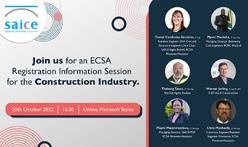
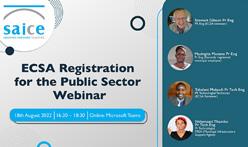

the SAICE SOS Growing Forward Champion. These webinars not only provide valuable information to students, but also underscore the benefits of maintaining membership in SAICE. The attendance at these webinars has been impressive, with a range of 120 to 280 members participating.


As the deadline for implementing the Identification of Engineering Work regulations approaches, SAICE has been working diligently to help ensure compliance. Over the past year, a dedicated task team, in collaboration with SAICE's various divisions, has developed a comprehensive code of practice for the civil engineering sector. This high-level document defines the scope of civil engineering work and will soon be published by ECSA. In addition, the team is working on developing addendums that will provide more detailed information on specialised areas like geotechnical and structural engineering.
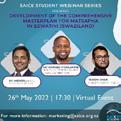

The SAICE Academy has been dedicated to expanding the range of training materials available on our online learning platform. We are committed to continuing this effort over the next several years, ensuring that our members have access to CPD from the comfort of their own homes. We recognise that attending an annual CPD course, as required by ECSA to maintain registration, can be a significant expense, not just in terms of the course
fees, but also the productive time lost in attending in-person courses. By offering CPD material that can be accessed at any time, we aim to make professional development more accessible and cost-effective for our members. The online learning platform can be accessed at cpdonline.saice.org.za.

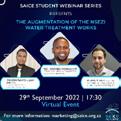
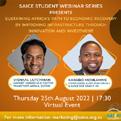



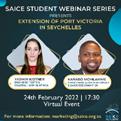
THE SAICE ACADEMY IS COMMITTED TO ADVANCING THE VARIOUS COMPONENTS OF SAICE’S GROWING FORWARD STRATEGY.
From an original membership of just 82 in 1903, which represented a significant portion of the civil engineering profession at the time, SAICE has remained the voice of civil engineering practitioners.


In the current difficult climate, SAICE has seen a slight increase in our membership totals for the first time since the start of the Covid-19 pandemic. At the end of 2021,
SAICE had a total of 15 468 members of which 9 795 members were in good standing. By the end of 2022, the total was 16 003 members of which 7 913 members were in good standing.
Our focus remains on growing our membership in all categories by driving the goals set out in SAICE’s Growing Forward
strategy, advancing technical knowledge and improving the practice and status of the civil engineering profession in South Africa.
Over the past year we have been collaboratively working on improving our members’ experience through the development of an automated customer



relationship management (CRM) system. This system will form the basis of SAICE’s new membership platform which will be launched soon. Our vision is to achieve a better user experience and ensure that our digital platform and technology infrastructure are secure and free of known vulnerabilities.







The year 2022 has been an exciting period of growth and transformation for the SAICE Future Leaders Panel (FLP), which has changed its name from the SAICE Young Members Panel to better reflect the identity of our members and the emerging trends in their careers.

During 2022, the SAICE FLP conducted a nationwide roadshow to invite new members to join and participated in several local, national, and international events. The Panel welcomed the participation of members from outside South Africa who have shared their international work experiences with members. The 2022 FLP Chair, Michael

Mhlanga, also represented the FLP at the 2022 World Engineering Conference in Costa Rica.
In addition, FLP successfully hosted Gauteng and Western Cape YMP socials, assisted in planning the Wits student chapter speed mentoring event, and attended various industry functions to support young professionals. SAICE FLP was also appointed to the FAEO Young Engineers Committee and served as judges for the 2022 World Engineering Day Hackathon. The team hosted brainstorming sessions with CESA YFP to strengthen collaborations and attended the Presidential Inauguration to welcome and support 2023 SAICE President Steven Kaplan.
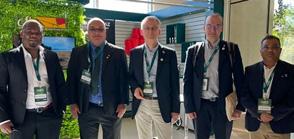

Moving forward into 2023, the Panel is committed to serving the growing demands of its members and identifying new ways
to support their professional growth. FLP will continue to promote the SAICE Growing Forward strategy and advocate for its vision through all eleven cardinal points.








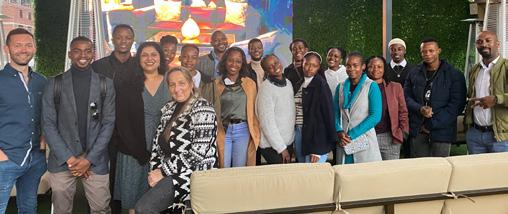
SAICE hosted its annual awards ceremony on 1 September 2022, celebrating individuals and organisations, as well as its members who have demonstrated resilience and promoted sustainability in the civil engineering profession. The SANRAL SAICE 2022 National Awards was a hybrid event held both online and inperson at Montecasino in Gauteng where over 300 guests attended.

WINNERS OF THE SANRAL SAICE
2022 NATIONAL AWARDS
Technical excellence, sponsored by SKI Civil and Structural Engineers
• Winner : Royal HaskoningDHV for the KwaZulu-Natal Department of Transport’s Sani Pass Phase 2: Roadworks – km 13.6 to km 25.0
• Highly commended: Zutari for Rand Merchant Banks’ RMB 8 Merchant Place
International projects

• Winner: Zutari for the Roads Authority Namibia’s Upgrade and Rehabilitation of Omaruru River Bridge, No. 435, in Henties Bay, Namibia
Community-based projects
• Winner: Naidu Consulting for the KwaZulu-Natal Department of Transport’s Construction of the Msunduze River Bridge No. 3202 on Local Road L3110
• Commendation: Royal HaskoningDHV for the Mossel Bay Municipality’s Brandwacht Pedestrian Bridge
Investigative or planning report or study
• Commendation: SMEC for the Investigation and Design of Remedial Works for Wall No. 2 on Main Road P73
Individual awards
• Engineer of the Year (Sponsored by Reinforced Earth) | Winner: Pierre van der Spuy from Zutari
• Young Engineer of the Year (Sponsored by Sika South Africa) | Winner: Shilpi Jain from Stantec, Australia
• Graduate Engineer of the Year (Sponsored by PPS for Professionals) | Joint Winners: Erin Da Silva from Hatch and Takalane Netshipale from the KwaZulu-Natal Department of Health

• Technologist of the Year | Winner: Kubendren Govender from Mariswe
• Young Technologist of the Year | Winner: Tevan Govender from Knight Piésold
• Young Technologist of the Year | Highly Commended: Duard Erasmus from AECOM
• Graduate Technician of the Year |
Commendation: Avuyile Mayekiso from ROMH Consulting
• Division of the Year (Division with more than 500 members) | Winner: Water Division
• Division of the Year (Division with less than 500 members) | Winner: Environmental Engineering Division
• Division of the Year (Division with less
than 500 members) | Commendation: Fire Engineering Division
• Branch of the Year (Branch with more than 500 members) | Winner: Durban Branch
• Branch of the Year (Branch with less than 500 members) | Winner: Bloemfontein Branch
• Branch of the Year (Branch with less than 500 members) | Commendation: Pietermaritzburg Branch
• Student Chapter of the Year
(Sponsored by PPS for Professionals) |
Winner: University of Johannesburg
APK Civils Chapter
• Student Chapter of the Year
(Sponsored by PPS for Professionals) |
Commendation: University of Johannesburg Doornfontein Chapter
• Student Chapter of the Year
(Sponsored by PPS for Professionals) |
Commendation: University of Stellenbosch Chapter
• Most Supportive Advertiser of the Year: Reinforced Earth
• Most Supportive Advertiser of the Year
Runner-up: Sizabantu South Africa
The Zutari photo competition awarded the creative portrayal of civil engineering activities or projects in the form of three winning images.
Winner: Bonisile Ndlovu, Beautiful
Concrete Pier

Second place: Erin Da Silva, Mirrored Perfection
Third place: Imraan Akhalwaya, Asphalt Paving
Keynote speaker Edmund Nxumalo, Interim CEO of ECSA, provided insights on the value and role of the engineering industry in driving critical infrastructure development


The South African National Roads Agency Limited (SANRAL) was the two-time naming rights sponsor for the annual awards, and SAICE was excited to partner with them again in 2022.

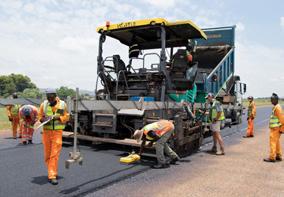
SAICE would like to sincerely thank all the sponsors and other stakeholders who helped
to make the awards a success. These include SANRAL, MUKONA Group, Murray & Dickson Construction, Mariswe, Sika, SKI Civil and Structural Engineers, Reinforced Earth, PPS for Professionals, and Zutari.
SAICE would also like to thank its team of adjudicators for giving so much of their time and expertise.

The bridge building teams consist of three learners each. They build model bridges from dowel sticks, glue and string, according to a technical briefing, and the event culminates in a bridge testing ceremony to determine the winners.
Bridges are tested to destruction to determine their loadbearing capacity
SAICE held its annual International Bridge Building competition on 26 August at the Midrand Conference Centre in Gauteng. Twelve schools participated in the grand finale, which saw great young minds from South Africa and Eswatini showcase talent, teamwork, innovation and design.
SAICE initiated the bridge building competition more than 30 years ago to further high school learners’ use of mathematics and science in an engineering context in order to grow the profession. The competition has therefore been a catalyst for many students to pursue a career in civil engineering.
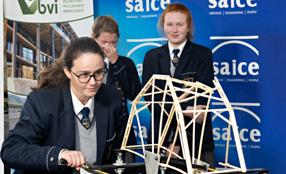
Owing to its practical and hands-on nature, this event is SAICE’s most successful initiative in attracting learners from previously disadvantaged rural schools, previous model C schools and private schools to civil engineering, as well as promoting a general awareness of the profession.
The bridges, adjudicated by a panel of engineers, are judged according to a system where design, correctness and aesthetics account for 30% of the total score, while the weight of the bridge and its weight carrying capacity make up the remaining score.
Brackenfell High School was the winner of this year’s International Bridge Building Competition. Their team comprised Philip Loubser, Sebastian Hahn, and Anthony Oosthuizen. Their bridge weighed 131.7 g and carried a weight of 164.1 kg.
Hoërskool Jim Fouché followed in second place with team members Yvé Kriel, Mieke Swarts, and Lourens van Niekerk. Their bridge weighed 106.4 g and carried a weight of 76.5 kg.
In third place was Fairvale Secondary School represented by Jamie-Lynn Marnce, Taliyah Goldstone, and Aeden Barlow. Their bridge weighed 108.6 g and carried a weight of 58.3 kg.
SAICE extends its appreciation to the sponsors of the competition to enable a successful event. These include WBHO, BVi Form-Scaff / Waco Engineering Services, RiChem and NRF-SAASTA.
The third place winners from Fairvale Secondary School: Taliyah Goldstone, Aeden Seth Barlow and Jamie-Lynn Marnce



The winning team from Brackenfell High School: Sebastian Hahn, Anthony Oosthuizen and Phillip Loubser
The second place winners from Hoërskool Jim Fouché: Yve Kriel, Lourens van Niekerk and Mieke Swarts


Very few interventions or career days have the advantage of practically illustrating what a career is all about. At the finals of AQUALIBRIUM, the SAICE Schools Water Competition, held at the Sci-Bono Discovery Centre in New Town, Johannesburg on 27 May 2022, participants and onlookers alike experienced just that.
The competition exposes learners to the intricacies involved in the design of water distribution networks and the actual delivery of water to households. Through this annual competition, SAICE also takes the responsibility of spreading the news that water should be used wisely, that infrastructure should be maintained, and

that new infrastructure should be developed to provide potable water to everyone in South Africa.
The teams are tasked with designing a model
water distribution network to distribute 3 ℓ of water equally between three points on the grid using two different diameter pipes and connection pieces. They are then judged on how well they execute the task, working on a penalty points system.
The grid used for the water distribution network is on a background that depicts the entire water cycle with all the major impacts affecting this scarce resource.
Regional winners came from as far as Bloemfontein, Cape Town, Durban, Kimberley, and Pietermaritzburg, to take on the teams from Johannesburg and Pretoria. After some tense moments during the construction of the water distribution network and the adjudication process, the team from Umlazi Commercial High School from Durban was announced as the winner, with only 11 penalty points.


In second place was the team from Moemedi Secondary School with 68 penalty points. In the third place, with 73 penalty points, was the team from Maritzburg Christian School.
SAICE thanks the sponsors, AQUAffection, Robust Engineers, the SAICE Water Division and SciBono, without which the competition would not have been possible.

Civil Engineering is SAICE’s official magazine, catering to the entire civils sector and covering all major civil engineering sub-disciplines. The monthly digital magazine is distributed to SAICE’s approximately 15 000 members, making it one of the most widely distributed magazines in its sector.


Civil Engineering is unique in that a large portion of its content is contributed by
SAICE members themselves, who, via the magazine, share experience and knowledge with their fellow members, ultimately contributing to the general body of civil engineering knowledge. Apart from featuring all civil engineering sub-disciplines, the magazine also informs SAICE members about the Institution’s networking activities with other engineering bodies, its young members’ activities, its career guidance initiatives, and about developments regarding codes and
standards. Other topics covered by the magazine include opinions on contentious engineering-related issues, book reviews, dispute resolution, market perspectives, service/product news, engineering history, personality profiles, and more.

The magazine is funded partially by membership fees and substantially by advertising. Despite a tough economic environment, the magazine continues to receive support from its loyal advertisers and the sales team has successfully exceeded advertising sales targets over the last two years. This support, combined with a decision to continue with a digital-only magazine, has enabled the continued production of a quality publication.
Advertising support has been strengthened by the magazine’s Know Your Sector Competition, which was introduced in 2020 to provide added value to advertisers by ensuring that all adverts receive attention. The competition offers readers a chance to win R10 000 in each issue by visiting the various advertisers’ websites (by clicking on their adverts) to find the answers to a multiplechoice quiz. The competition has been well supported and SAICE had awarded 27 lucky readers a combined total of R270 000 by the end of 2022.
Civil Engineering experienced good participation and encouraging feedback from members in 2022, and members continue to receive an attractive and informative monthly magazine.


The publication of peer-reviewed technical research papers on civil engineering remains one of SAICE’s core functions, as it consistently adds to the body of civil engineering knowledge of which the Institution, as a learned society, is the keeper. The forerunner of SAICE was established in 1903 precisely to share civil engineering knowledge and experience. Those early meetings in fact consisted mainly of papers being presented to and discussed by fellow engineers.
The Journal of the South African

Institution of Civil Engineering , which appears quarterly in March, June, September and December, is internationally accredited by Thomson Reuters Web of Science. The journal is also accredited by SciELO (Scientific Electronic Library Online) and hosted on its website, which is an open-access platform for scientific journals. The South African arm of SciELO is managed by the Academy of Science of South Africa (ASSAf) under the auspices of the Department of Science and Technology. These two accreditations automatically ensure accreditation by the Department of Higher Education and Training (DHET).

The online visibility of SAICE’s journal continues to attract considerable interest. Since the journal’s inclusion on the SciELO website in 2010, for example, SAICE journal papers have been downloaded from that particular site approximately 950 000 times (by the end of September 2022). In addition, the journal is hosted on the SAICE and Sabinet websites, thereby further enhancing its local and international visibility.
It has now become compulsory for journals accredited by SciELO to register with the Directory of Open Access Journals (DOAJ). This would also ensure continued

accreditation of the SAICE journal by the DHET. Preparations are in progress to apply for registration with the DOAJ during the course of 2023.
The production of the journal is funded by membership fees, while peer-reviewing and assessment of submitted papers are done on a voluntary basis by an expert team of moderators and reviewers, currently under the leadership of Dr Peter Day as Editor-in-Chief. We thank all our reviewers and moderators sincerely for the many hours they have thus far spent on this very important work.



SAICE’s audited annual financial statements incorporate the group consolidated financial position for SAICE NPO, including its branches and divisions, as well as its subsidiary, SAICE (Pty) Ltd.

The SAICE group consolidated financial results show an audited operating surplus in 2022, with 12.1% growth in total revenue, totalling R36.12 million after cost of sales (vs R32.21 million in 2021).
Operating expenses totalled R33.32 million compared to R31.49 million in 2021 (growth of 5.8%). The ‘total comprehensive surplus’ for the year is R4.45 million. The accumulated surplus has increased to R25.66 million.
The current auditors, Mazars, were appointed by the SAICE Council in 2019. We are proud to announce that the 2022 audit report is unqualified and thank all of SAICE’s staff and officials for their commitment and cooperation in this regard.
The total equity of R33.28 million reflects an increase of just over R5 million compared to 2021.
The ‘statement of changes in equity’ reflects total equity as follows:
• Group accumulated surplus: R25 665 225
• SAICE NPO Infrastructure Report Reserve Fund: R2 036 269
• SAICE NPO Insurance Reserve Fund: R852 399
• SAICE NPO Special Purposes Fund: R3 357 111
• SAICE NPO Patrons Bursary Fund: R1 321 499.

Total revenue from operations for 2022 is R37.83 million compared to R33.63 million in 2021.
SAICE NPO revenue increased by 7.2% in 2022 while revenue from SAICE (Pty) Ltd increased by 22.9%. Revenue highlights for 2022 include:
• Book sales: R3.1 million
• Branch revenue: R1.3 million
• Courses revenue: R5.8 million
• Division revenue: R846 000
• Magazine advertising revenue: R2.6 million
• Membership revenue (after discount and fee exemptions): R21.1 million.
Membership revenue, after early bird discount and fee exemptions, comprised 55.8% (vs 61.4% in 2021) of total group revenue. The early bird discount, which allowed for payment by 31 December 2021, was 20%. Early payment take-up amounted to 11.4% (vs 12.8% in 2021) of membership subscription fees, resulting in a total benefit of R2.72 million (vs R3.04 million in 2021) going back to members.

Student membership is free and SAICE invested R1.65 million (vs R1.30 million in 2021) in fee exemptions for our full-time student members.
The SAICE National Office Finance Department would like to thank all involved for their input, which has contributed to SAICE maintaining a strong financial position. We appreciate the continued commitment of our volunteers and staff members.